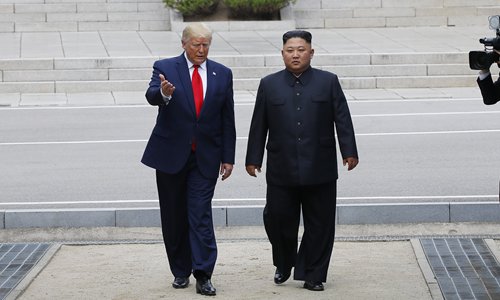HOME >> OPINION
Will Kim-Trump DMZ meet set doves cooing?
By Zhao Lixin Source:Global Times Published: 2019/7/4 17:23:40

Photo: VCG
When US President Donald Trump attended the G20 summit in Japan on June 29, he tweeted: "If Chairman Kim of North Korea sees this, I would meet him at the Border/DMZ just to shake his hand and say Hello (?)!" Many people regarded it as a start of a normal day with the banter of an unpredictable Trump, but what followed took the world by great surprise.
Trump met North Korean leader Kim Jong-un at the Demilitarized Zone (DMZ) between North and South Korea the next day, becoming the first sitting US president to set foot in North Korea. Trump also invited Kim to meet him at the White House.
In the past few days, speculation has been rife about the meeting - was it impromptu? In the document signed by Trump on June 21 to extend the national emergency with respect to North Korea declared in Executive Order 13466, North Korea's moves were still described as "an unusual and extraordinary threat."
Kwon Jong-gun, director-general of the Department of American Affairs of the North Korean Foreign Ministry, criticized the North Korea policy of the US on June 27, and said the talks should be carried out with a counterpart who has "a good sense of communication," and it could be possible only when the US puts forward "a proper counterproposal."
However, less than 48 hours later, Kim and Trump met for the third time. Even if it was unplanned, it worked in favor of bilateral interests. It is historical to hold a meeting of top leaders between the US and North Korea in Panmunjom, which is located between the two Koreas.
Pyongyang has no reason to feel dissatisfied. The president of the world's most powerful country has given an invitation to its leader. Though the meeting with Trump was informal, Kim didn't want to miss the opportunity. After all, Panmunjom was the place where the Korean Armistice Agreement was signed 66 years ago. Kim wanted to demonstrate to the world Pyongyang's resolve for peace and development at the historical zone. More importantly, being able to maintain dialogue with the US head of state at least means Kim's diplomatic strategy has not failed.
For Trump, the visit to the truce village of Panmunjom is more than a political show. This time the world has realized that by setting foot in North Korea, Trump was not being bellicose. He tried to convince more people that the danger seen to be lurking has disappeared since the first Kim-Trump summit in Singapore in June 2018. Trump also intended to break the denuclearization stalemate on the Korean Peninsula. He told reporters after the meeting he would set up a working team with North Korea to hold talks within two or three weeks.
More behind-the-scenes factors may have contributed to the dramatic meeting at Panmunjom. Some analysts hold that Trump hoped to shift the focus of Americans from the Democratic presidential primary debates to himself. A shocking photo of drowned Mexico migrants trying to cross the border to seek asylum published recently ignited renewed criticism of Trump's immigration policy. Besides, Trump has long hoped for a breakthrough on the Korean Peninsula denuclearization issue, perhaps a path to the Nobel Peace Prize and get more votes for his re-election. This has given North Korea the opportunity to bargain.
Most importantly, the Trump administration has realized that resolution of the nuclear issue needs a drawn-out process of multilateral cooperation. Not only did Trump's plan of complete, verifiable and irreversible denuclearization (CVID) fail to pass Pyongyang's muster, it also lacked rationality. Since the second half of 2018, Washington has renamed CVID as FFVD (final, fully verifiable denuclearization). Trump has had to focus on long-term containment rather than short-term solutions.
Reality demands that US policy on North Korea be flexible. In the near future, the maximum pressure technique might have to give way to strategic forbearance. Trump intended to break the impasse in denuclearization negotiations on the peninsula during his trip to the DMZ by sending a strong signal to adopt political solutions. The Trump administration is also likely to move closer to Beijing and Moscow in terms of the solution framework.
Will this DMZ meeting lead to an official Kim-Trump summit in Washington? First, it depends on the progress of negotiations. From the US perspective, the possibility to lift economic sanctions on North Korea hinges on Pyongyang's steps in the future. Second, the US sense of urgency to resolve the nuclear issue needs to be factored in. In the long run, the current impasse is to North Korea's disadvantage.
If Kim goes to the US, he must realize that he is dealing with a powerful adversary. However, the third Kim-Trump summit will not materialize until a new and greater political compromise is struck.
The author is professor and director of the School of International Politics, Institute of Politics and Public Management, Yanbian University. opinion@globaltimes.com.cn
Posted in: